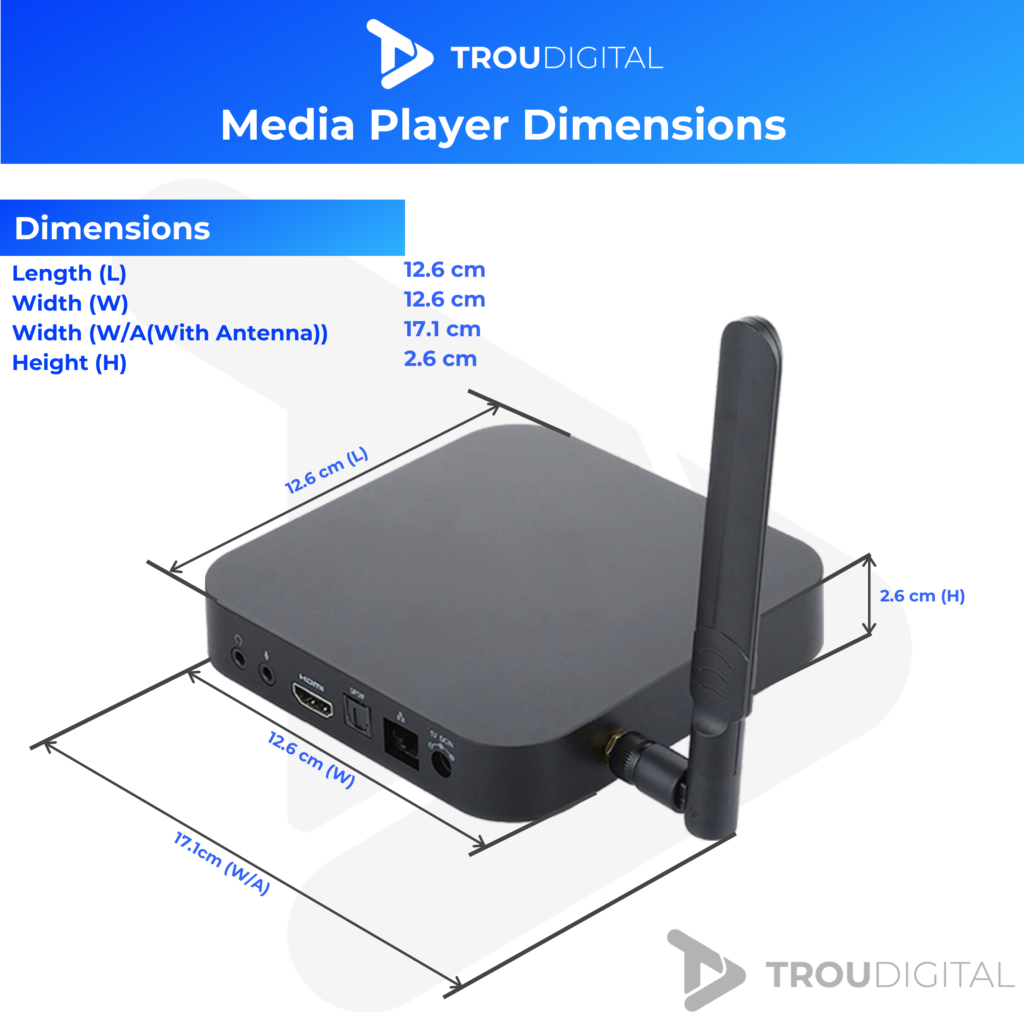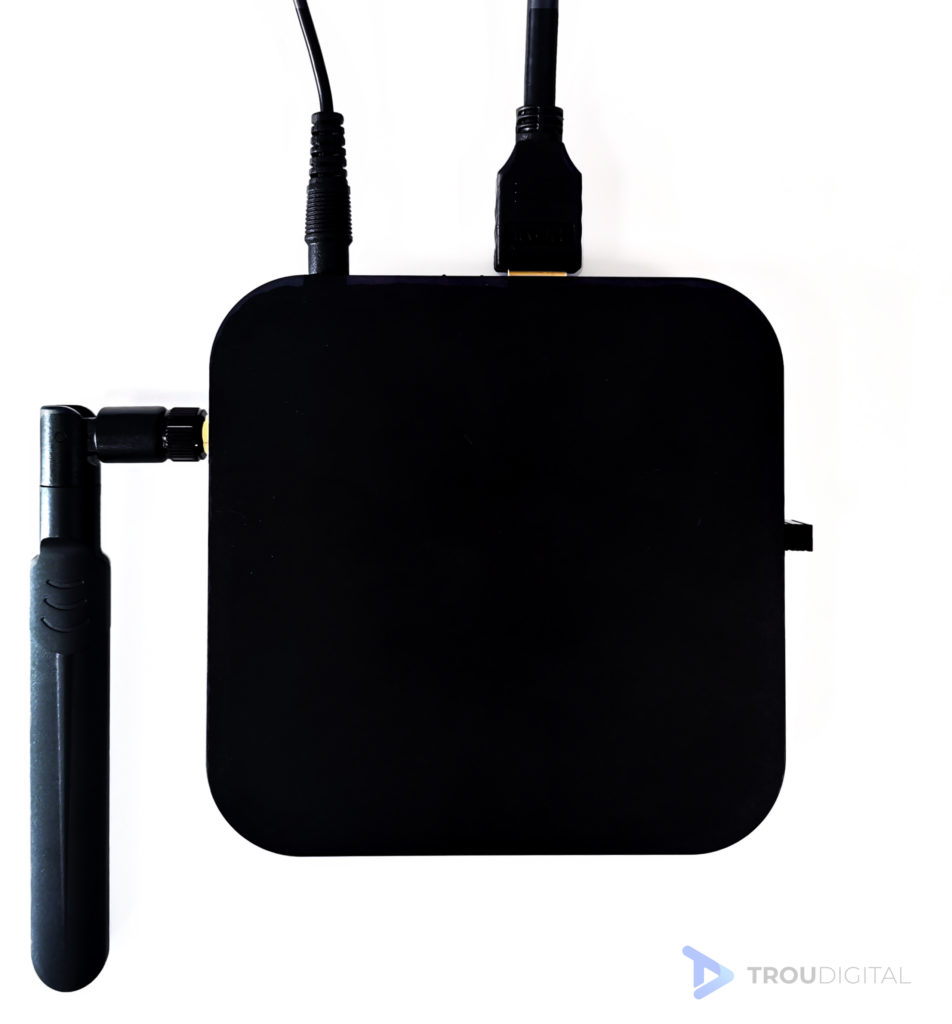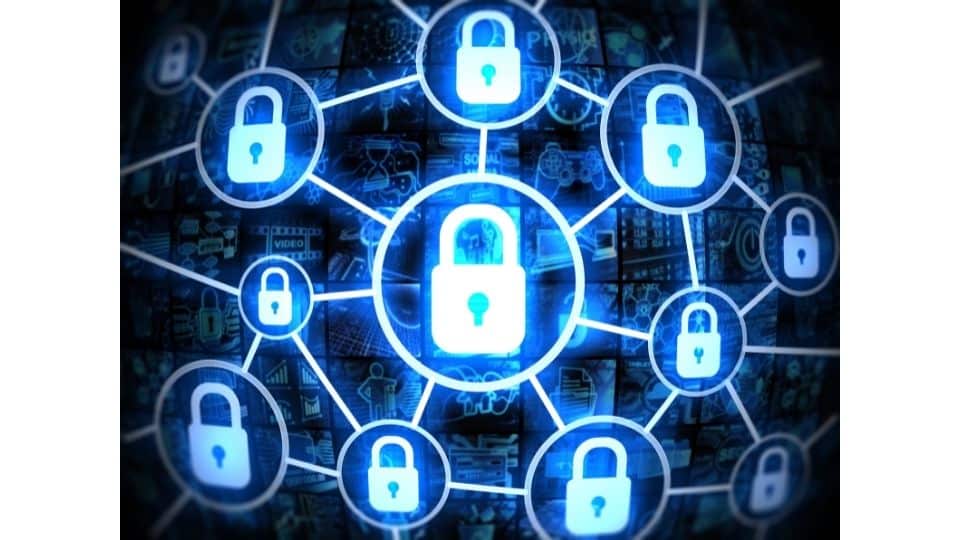Not so long ago, the digital signage industry was rocked with the introduction of the media player. Within weeks of its introduction, digital signage users were jaw dropped. They could now control all of their screens from one location. This meant no more driving around for hours on end to individual sites to update content. They could now do this at home in their PJs! What’s more, this powerful piece of technology has the ability to transform any screen into a smart digital signage display.
Put simply, a user connects a media player to their screen and the internet. The media player connects to digital signage software. When users make updates on the software, they are reflected on the screen. Due to being done over the cloud, this allows for a lot of flexibility, when it comes to planning, scheduling, and updating screen content.
Thanks to features like small size, high power, and low cost, media players have been the go-to hardware choice for any digital signage project. With that being said, however, some users are still opting for large PCs or Laptops to power their screens. These users however have run into a handful of problems which we investigate below.
In this blog, we look at how the media player stacks up to a PC regarding digital signage projects.
Eco-Friendliness
In recent weeks, world scientists have given humans a huge slap in the face regarding climate change. The Intergovernmental Panel on Climate Change (IPCC) released a shocking report, detailing drastic environmental changes to the world that are happening as a direct result of climate change. In response to the findings of the report, we’ve all been urged to act in a more eco-friendly manner. This means increased recycling, less driving, and planting more trees.
The worry of climate change has reached companies too. The worlds leading companies are quickly making changes to their mission statements and adding ‘Net Zero’ into their company targets. These companies are now looking at business solutions that leave a much smaller carbon footprint. Methods include carpooling, cycle to work schemes, bring your own cutlery, reusable coffee cups, installing solar panels, reducing energy demand, and more. Other popular techniques include cutting down paper usage to save trees. This can be easily achieved by utilising email, social media, or digital signage instead of posters, leaflets, letters, etc.
Although going digital over paper-based material is a great first step, organisations can still do more to further reduce their impact on the environment regarding digital screens. We look at the difference in environmental impact between a company using a desktop PC to power their screens, vs a media player.
Power Consumption and Cost
In terms of the environment, reducing energy usage is critical. By reducing your energy usage, you cut down the output of harmful power sources that rely on fossil fuels and do great damage to the environment. That’s why it’s important to make reductions as much as possible. In addition to this, reduced power consumption equals a reduced electricity bill. If you can reduce power consumption across multiple channels and projects across your organisation, it could have a massive impact on your bottom line.
A regular desktop PC uses 100 watts per hour (0.1 kWh). Based on the average cost per kWh in the United Kingdom, which is £ 0.1437, a PC that is operated 24 hours a day would cost 34 p a day. This totals £126 a year per connected PC. If you have a 50 screen network, your PCs are costing you £6,300 a year in electricity alone! In contrast, Android media players consume ten times less energy – only 10 watts per hour. If the media player is on 24 hours every day, this accounts for £12.60 a year. If you multiply this over a 50 screen network that’s £630 a year in electricity for 50 media players, a yearly bill saving of £5,670.
CO2 Output
CO2 is a greenhouse gas that is contributing to the earth’s rising temperatures. With CO2 levels rising faster than ever, scientists urge us to reduce our CO2 output wherever we can. This means driving less, walking more, making homes more efficient, etc.
The main contributor to rising CO2 levels is electric power consumption. A single kWh of energy will produce 0.256kg of CO2. Simply put, the less energy we demand, the less CO2 we produce.
Let’s put PCs and media players head to head.
A PC that operates 24 hours a day uses 2.4 kWh. With the emissions factor for electricity being 0.256 kg of CO2 per kWh, a PC that is being used for digital signage all the time produces as much as 224 kg of CO2 a year. As we saw above media players only consume 10% of the power PCs do. This means they also only produce 10% of the CO2 an average PC would. If we run the numbers we find that a media player produces 22.4 kg a year.
Let’s apply these figures to a 50 screen network like above. A 50 screen digital signage network using PCs would produce 11,200kg of CO2 in one year. In contrast, 50 media players will produce roughly 1,120kg of CO2. The 50 screen network using media players will save up to 10,080kg of CO2 a year.
Why it Matters
To put this energy saving in perspective an average tree can absorb around 30 kg of CO2 a year. This means to offset the CO2 produced by the 50 PCs you would need over 373 trees. For media players, you would need just over 37 trees. Switching to media players would free up 336 trees for absorbing CO2 from other sources and ultimately have a huge impact on our environment.

The Costs of a Digital Signage Media Player
Costs and budgets remain top of mind for many organisations when it comes to implementing new technology. When implementing new solutions the best solutions can also be the most expensive ones. However, this is not the case with media players.
For digital signage, it is often the case that you will need one media player (or PC) for each screen you are planning to send content to. Therefore, if you are installing a large screen network, you will need to think of the hardware costs that multiply over multiple sites. Let’s see how the numbers add up.
According to Statista, the average PC costs around $733 (or £562.80 in our case). If we take this figure and multiply it across a 50 screen network that’s £28,140. In contrast, a standard media player will cost around £185. For a 50 screen network that will cost £9,250. As a result, an organisation saves £18,890 just by using media players!
Furthermore, we also discovered that media players are far cheaper to run as they consume less power. Additionally, media players are easier and more cost-effective to replace due to their small size. With no moving parts (standard media player), they are less likely to experience hardware failures. This can help keep future project maintenance costs down. All this without sacrificing performance…
Digital Signage Media Player Size
The size of your PC or media player is another important aspect to consider when embarking on a digital signage project. Smaller devices are easier to hide and ensure your screens look sleek.
It might seem surprising that a media player the size of a thick slice of bread has so much power… but it’s true! Our standard Android media players we use are typically 12.6 x 12.6 x 2.6 cm (L x W x H). This makes them a convenient, compact solution and can easily be hidden out of sight, behind a screen, or even inside a digital kiosk. Additionally, media players only weigh around 700g, further adding to the ability to keep projects compact.
Now we draw our attention to a PC solution. A standard Mini Tower PC is over double the size of a media player with the following dimensions – 35 x 40 x 17 cm (L x W x H). Although still small enough to fit on a desk, the additional length, width, and height make these PC’s harder to keep hidden and install behind screens. If a user is using a larger, standard-sized tower desktop PC, this effect is massively amplified.
Apart from desktop PCs, there are more compact solutions out there. Mini PCs are much smaller in size (not to be confused with a mini-tower PC), averaging around 25 x 25 cm.
A large problem around deploying larger PCs is that they likely need to be installed out in the open, or in another room with extremely long display cables. Not only can this pose a security risk, but it’s also extremely inconvenient.

Hardware Lifetime
Project lifetime is extremely important for any decision-maker in an organisation. When they embark on a project of any kind they want it to last, involve as little maintenance possible, and not drop performance. Think about it, would you pay a roofing company to renew the roof of your home or business knowing you would need to replace it within a year or two? No, you want a long-lasting roof with peace of mind knowing it’s not going to send you dipping back into your pockets. The same goes for hardware.
If you’re introducing digital signage at your organisation, it is likely your screens will be running most hours of the day (16+). This means whatever device is powering your screens will be working all day too. Therefore, it’s important to choose a solution that’s going to deliver performance whilst keeping costs low and your content sexy.
PCs tend to have lots of moving parts and parts that need plugging in (fans, disk drives, graphics cards, RAM sticks). This can make PCs more prone to hardware failures over long periods of usage. They can also be easily damaged in the event of dropping the PC etc. This large amount of separate (and larger) parts result in a larger casing which makes it harder to keep your PC concealed.
In contrast, media players have no moving parts and are more robust. This results in more efficiency, lower weight, and less noise. Furthermore, there is less wear and tear over extended usage, prolonging the life of your player. Fewer moving parts, resulting in less power consumption, again helping keep costs down.

Security
Many large organisations require solutions that are not only convenient but also secure. This is especially true for places, where screens display information important to visitors or go out to a sensitive audience. For example, airports need to ensure that screens, which show flight information are running without interruptions and can’t be tampered with. The last thing an airport wants is a passenger getting into the screen and putting their own content on! Luckily, there are multiple ways to secure a media player.
One option is to lock the media player’s software. Special software can keep a media player locked to one specific app (signage software). Users can’t leave the app unless they have access to specific security credentials. This ensures your content on-screen doesn’t get tampered with.
When it comes to securing the hardware, users have a number of options. Users can use a Kensington lock. The lock consists of a metal anchor secured with a key or combination lock, which is attached to a metal cable. This massively reduces the ease and ability of thieves to remove the media player. As a result, your hardware, data, and content are protected.

If you have any questions about digital signage media players, speak to an expert today. Call our friendly team on 02380 981110 or Email info@troudigital.com for a no-obligation consultation. Alternatively, click the button below.
